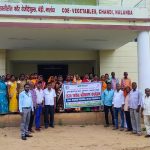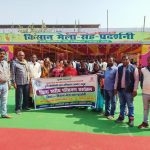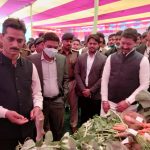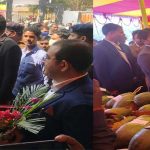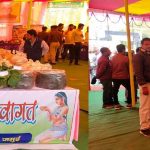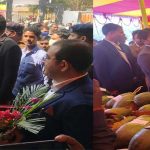

UPDATES
DOWNLOAD

About ATMA Jamui


ATMA, Jamui is an autonomous body registered society responsible for technology dissemination at district level. It is a focal point for integrating research extension and marketing. It decentralized day to day of the Agricultural Technology management System. It allows receiving and expanding project funds entering into contracts and agreements and maintaining revolving accounts. It has also linkage with all the line department research organizations nongovernmental organizations and organizations associated with agricultural development in the districts.
The key functions of ATMA governing board are as following.
- Review and approve strategic research and extension plan and annual action plan for the district.
- Receive review annual reports presented by the participating unit and to provide feedback and direction to them.
- Receive and allocate project funds to carry out projects research and extension activities.
- Foster the organization and development of farmers’ organization and farmer interest group.
- Facilitate the grater involvement of private sector.
- Encourage agriculture credit institutions to increase the availability to capital to resource poor farmers.
- Arrange for the periodic audit of ATMA financial accounts.
- Adopt and assess the rules and by laws for the ATMA.
Block Farmer Advisory Committee (BFAC)
In the ATMA model, BFAC (Block Farmer Advisory Committee) is another important institutional innovation. BFAC is supposed to establish at each block. The BFAC has two components one is block technology team (BTT). The BTT is comprised of block level officials of agricultural, horticulture animal husbandry etc. BTT is constituted by involving farmer representative from regular basis at BFAC to ensure stakeholder involvement and to sit program priorities at block level. It helps to establish a demand driven extension system by providing formal feedback and in building better accountability to extension services. BFAC ensures bottom up planning by preparing block action plan and submits to ATMA for funding.
ATMA is an autonomous institution set up at district level to ensure delivery of extension services to farmers. ATMA Governing Board is the apex body of ATMA which provides overall policy direction. ATMA Management Committee is the executive body looking after implementation of the scheme. District Farmers Advisory Committee is a body to provide farmers’ feedback for district level planning and implementation. With dedicated staff provided for the ATMA, it will continue to be the district level nodal agency responsible for overall management of agriculture extension system within the district, including preparation of Strategic Research and Extension plan.
The Block ATMA Cell consisting of Block Technology Team (BTT) (a team comprising officers of agriculture and other allied departments within the block) and Block Farmers’ Advisory Committee (BFAC) (a group exclusively consisting of selected farmers of the block) will prepare the Block Action Plan (BAP) and provide necessary extension support within the Block in its execution.
Agri-entrepreneurs, Diploma holders in Agricultural Extension Services for Input Dealers (DAESI), Input Dealers and extension workers in non-governmental sector will supplement the efforts of extension functionaries. Commodity Interest Groups (CIGs), Farmer Interest Groups (FIGs) and Food Security Groups (FSGs) will serve as a nodal point for information & technology dissemination among its members. Farm Schools will serve as a mechanism for farmer-to-farmer extension at every Block.
The following Committees shall be set up at various levels.
➢ State Level:
(i) Inter- Departmental Working Group (IDWG), (ii) SAMETI Executive Committee & (iii) State Farmers Advisory Committee (SFAC)
➢ District Level:
(i) ATMA Governing Board, (ii) ATMA Management Committee & (iii) District Farmers Advisory Committee (DFAC)
➢ Block Level:
(i) Block Technology Team (BTT) & (ii) Block Farmers Advisory Committee (BFAC)
Process Flow for Action Plans: SREP is a comprehensive document identifying research/extension priorities for district, keeping in mind Agro-ecological conditions and existing gaps in technology generation & dissemination in all agriculture and allied sector areas/activities including Horticulture, Animal Husbandry, Dairying & Fisheries. All extension related activities under other schemes of DAC&FW will naturally form part of SREP. SREPs will be prepared in coordination with the line departments, NGOs, Krishi Vigyan Kendras (KVKs), Panchayati Raj Institutions (PRIs), Private Sector, farmers and other stake-holders at the district level.
Similar training & field extension related components in other programmes of DAC&FW and State Governments will also be implemented through ATMA.
Funds earmarked for such activities under different Schemes/Programmes will be utilized through ATMA. Similarly, ATMA funds also will be suitably used to cover training & field extension objectives/activities of other Schemes/Programmes. Such convergence arrived at through SREP/SEWP will avoid duplication and ensure wider coverage in terms of outreach to farmers and gamut of activities. Various Action Plans shall emanate from SREP as follows:
These SREPs are Five years vision documents which shall be revisited to accommodate newly identified gaps and emerging areas of importance.
- SREPs will form the basis for formulation of Block Action Plans (BAPs) on an annual basis. Block Action Plans are then consolidated at the district level to prepare the District Agriculture Action Plans (DAAPs).
- District Plans are worked out in such a manner that these serve as subset of the Comprehensive District Agriculture Plans (CDAPs) prepared for the District under Rastriya Krishi Vikas Yojana (RKVY).
- The DAAPs will be consolidated in the form of State Extension Work Plan (SEWP) which then forms a part of State Agriculture Plan (SAP).
SPECIALIST & FUNCTIONARY SUPPORT: Extension related manpower is proposed at three levels viz. State, District and Block level.
District Level: Each ATMA Unit consisting of the following core staff of five persons, under the overall supervision of PD, ATMA, will be responsible for management of agricultural extension services within the District including holding of regular meetings of ATMA Management Committee (MC) and ATMA Governing Board (GB):
(i) Project Director – 1
(ii) Deputy Project Directors – 2
(iii) Accountant-cum-Establishment- Clerk – 1
(iv) Computer Programmer/ Operator – 1
The Project Director ATMA shall report to the Chairman, ATMA GB and also function as Chairman of ATMA Management Committee.
Block Level:
(i) One Block Technology Manager (BTM) is provided in each Block to co-ordinate the ATMA related activities of the BTT and BFAC. BTM will work under the overall supervision of the BTT Convener for all ATMA related activities at the Block level.
(ii) On an average three Assistant Technology Managers (ATMs) are to be placed in each Block (2 to 4 depending on size of the Block) exclusively for delivery of extension services in agriculture and allied sectors as per priority areas for various Blocks.
(a) In N.E. states and other hilly States viz. H.P., J&K, and Uttarakhand, the number of ATMs deployed per block should be as follows:
Blocks having upto 5000 farm households and the area of the Block being upto 800 sq. km, 2 ATMs would be deployed. However if the area of the Block is more than 800 sq.km, 3 ATMs could be considered;
(b) In all other States Blocks having upto 12000 farm households and the area of the Block being upto 1000 sq. km, 2 ATMs would be deployed. However, if the number of farm households/ Block exceeds 20000 and the area of the block is more than 1000 sq.km, the deployment of ATM can go up to 4. All other Blocks will have 3 ATMs. However, average figure of more than 3 per state will need to be concurred by the Government of India, so that overall country average does not exceed 3. The areas of expertise (i.e. Agriculture, Horticulture, Animal Husbandry, Dairying, Fisheries etc.) of these ATMs will be decided based on priorities for various Blocks. These ATMs shall be provided requisite connectivity and mobility to perform the requisite functions.
(c) Block level and District level manpower available under various schemes will be pooled for regular coverage of groups of Villages/Panchayats for extension related expertise. However, domain expertise of various extension personnel in a Block/District will be suitably used to ensure all-round outreach to farmers.
(d) Panchayat-wise roster giving the name and mobile number of the extension workers’ availability on the pre-decided days (giving day of a week/fortnight etc.) will be displayed on a Board at vantage points in various villages. This Display Board will also contain contact details of other agricultural functionaries of the area.
Training and Exposure Visit





















